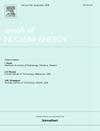Modeling and simulating of the gas flow inside a molecular pump with different geometries by Monte Carlo method to predict the compression ratio
IF 1.9
3区 工程技术
Q1 NUCLEAR SCIENCE & TECHNOLOGY
引用次数: 0
Abstract
The molecular pump is a fixed piece in the outer space of the rotor in a gas centrifuge. The molecular pump has grooves that, when moving particles collide with it, regarding the grooves are diverted in the direction that will be routed back into the rotor. One of the molecular methods for analyzing the flow of gas inside the molecular pump’s groove is the DSMC method. In this paper, while modifying the Sickafus analytical method, a trapezoidal groove of a molecular pump and a molecular pump with full geometry have been simulated using the dsmcFoam solver in OpenFOAM. The results of DSMC simulation have been compared with the results of the modified Sickafus analytical method. Also, simulation of the molecular pump with rectangular, triangular, and semi-circular geometries has been performed, and the results have been compared with the analytical method. The results show that the semicircular geometry creates the highest compression ratio during the molecular pump. Also, the results show that by improving the Sickafus analytical method, it is possible to achieve an accurate answer with a high-speed analytical method without the need to simulate the molecular pump with complex and high computing time method such as DSMC.
采用蒙特卡罗方法对不同几何形状的分子泵内部气体流动进行了建模和仿真,以预测其压缩比
分子泵是气体离心机转子外空间的一个固定部件。分子泵有沟槽,当移动的粒子与它碰撞时,这些沟槽就会被转移到将被路由回转子的方向。分析分子泵槽内气体流动的分子方法之一是DSMC方法。本文在改进Sickafus分析方法的同时,利用OpenFOAM中的dsmcFoam求解器对分子泵的梯形槽和全几何形状的分子泵进行了模拟。将DSMC模拟结果与改进的Sickafus分析方法的结果进行了比较。此外,还对分子泵进行了矩形、三角形和半圆几何形状的模拟,并与解析方法进行了比较。结果表明,半圆形结构在分子泵过程中产生了最高的压缩比。同时,结果表明,通过改进Sickafus分析方法,可以在不需要DSMC等复杂且高计算时间的方法模拟分子泵的情况下,使用高速分析方法获得准确的答案。
本文章由计算机程序翻译,如有差异,请以英文原文为准。
求助全文
约1分钟内获得全文
求助全文
来源期刊

Annals of Nuclear Energy
工程技术-核科学技术
CiteScore
4.30
自引率
21.10%
发文量
632
审稿时长
7.3 months
期刊介绍:
Annals of Nuclear Energy provides an international medium for the communication of original research, ideas and developments in all areas of the field of nuclear energy science and technology. Its scope embraces nuclear fuel reserves, fuel cycles and cost, materials, processing, system and component technology (fission only), design and optimization, direct conversion of nuclear energy sources, environmental control, reactor physics, heat transfer and fluid dynamics, structural analysis, fuel management, future developments, nuclear fuel and safety, nuclear aerosol, neutron physics, computer technology (both software and hardware), risk assessment, radioactive waste disposal and reactor thermal hydraulics. Papers submitted to Annals need to demonstrate a clear link to nuclear power generation/nuclear engineering. Papers which deal with pure nuclear physics, pure health physics, imaging, or attenuation and shielding properties of concretes and various geological materials are not within the scope of the journal. Also, papers that deal with policy or economics are not within the scope of the journal.
 求助内容:
求助内容: 应助结果提醒方式:
应助结果提醒方式:


